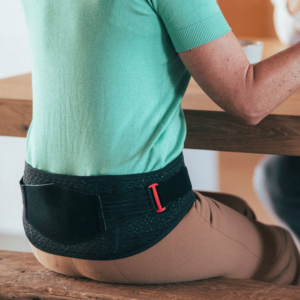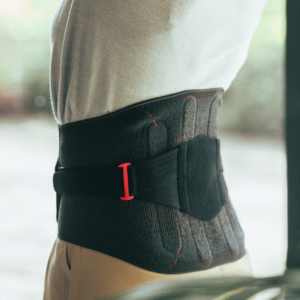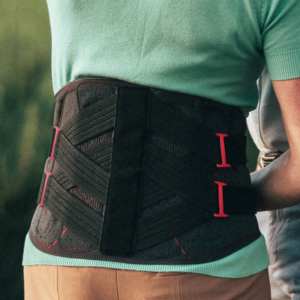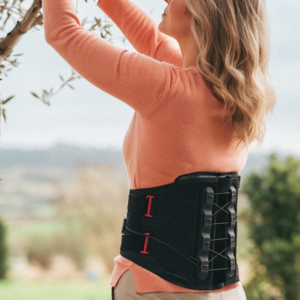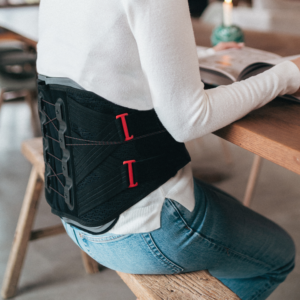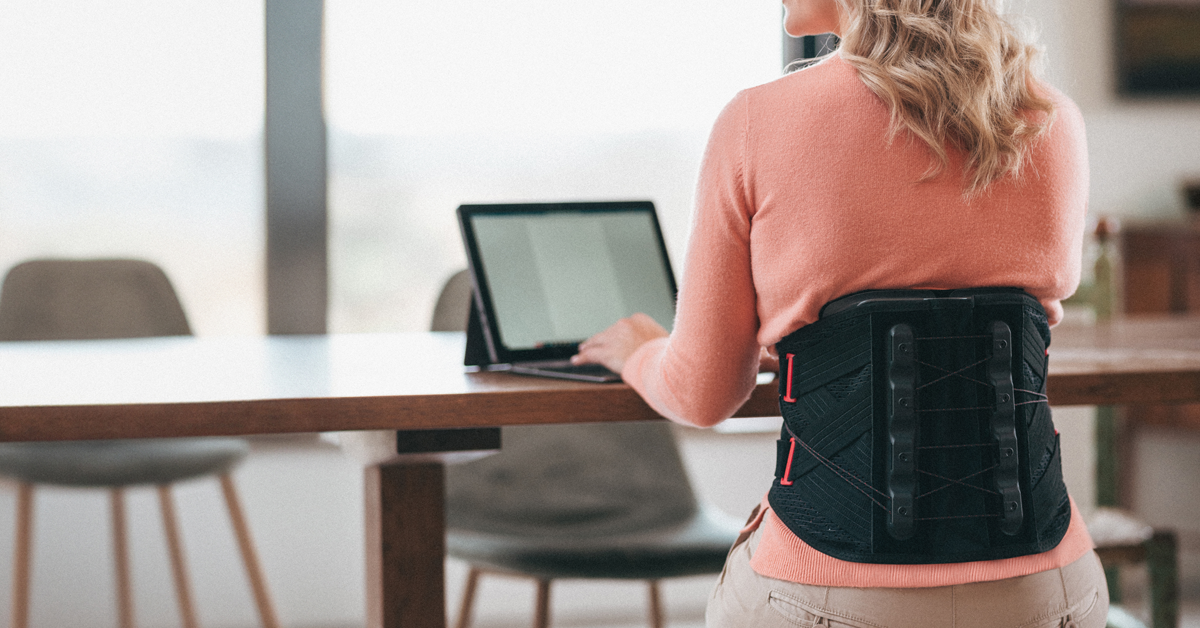Low back pain is an increasingly widespread issue1 that can often be relieved through the use of a back brace2,3,4. The new DonJoy LumboForce® range provides a versatile option for low back pain sufferers, offering six distinct products that cater to various levels of lumbar spine support. From light support for mild discomfort to more advanced braces for severe conditions, this refreshed range of products embodies a modular approach to back care, ensuring both patients and healthcare professionals have access to the right tool for the job.
DonJoy LumboForce® Sacro: new targeted support for sacroiliac and pelvic stability
Specifically designed for stabilizing the pelvis and relieving pain in the sacroiliac (SI) joint, the new LumboForce Sacro features dual repositionable proprioception pads. These pads not only massage the affected area to promote blood circulation, but also offer flexible support tailored to the patient’s needs.
The brace’s semi-elastic webbing and bilateral straps ensure that compression is both supportive and adjustable, making it an excellent choice for conditions like symphysis insufficiency and sacroiliac joint trauma.
DonJoy LumboForce® 1: moderate support with comfort in focus
For patients needing moderate lumbar support, LumboForce 1 offers a balance of comfort and stability. It features flexible dorsal stays that support the affected spinal segments, providing support and helping to reduce pain.
The addition of a repositionable proprioception pad massages the lower back to help relieve discomfort. This brace is particularly suitable for those dealing with lumbalgia, osteochondrosis, or spondylarthrosis, conditions that benefit from moderate stabilization without restricting movement.
DonJoy LumboForce® 2: enhanced compression with customizable support
Taking the support up a level, the LumboForce 2 introduces bilateral straps that allow for greater control over compression. This feature is useful for patients who need variable support throughout the day, as it enables them to adjust the brace to their comfort.
Like LumboForce 1, this model includes flexible dorsal stays and a repositionable proprioception pad, making it suitable for managing both acute and chronic low back pain.
DonJoy LumboForce® 3: partial immobilization for severe lumbar conditions
LumboForce 3 is designed for patients requiring more substantial support and partial immobilization of the lumbar spine. This model can be particularly beneficial for conditions like spondylolisthesis, facet syndrome, and herniated discs in the early stages.
The adjustable dorsal stays and double bilateral straps provide a superior level of compression, while the option to choose between two heights (26 cm and 32 cm) helps ensure a proper anatomical fit for both men and women.
DonJoy LumboForce® 4: advanced stabilization for serious spinal issues
For those with more severe spinal conditions, such as advanced herniated discs or lumbar spinal canal stenosis, LumboForce 4 offers advanced support. This brace features a rigid aluminum back frame that bridges the lumbar spine, providing partial immobilization crucial for healing.
The bilateral pulley system and flexible dorsal stays work together to offer a higher level of compression and support, while the adjustable swiveling wings ensure the brace adapts to the patient’s movements. This design not only enhances comfort but also helps ensure that the brace remains effective throughout the healing process.
DonJoy LumboForce® 5: maximum immobilization for critical support
LumboForce 5 provides the highest level of support and immobilization in the range. This model is engineered for conditions that require greater lumbar immobilization, such as advanced stages of herniated discs, stable vertebral fractures, and severe spinal stenosis.
The rigid back shell, combined with dynamic side wings and a rigid abdominal pad, ensures over 50% circumferential waist support. The bilateral pulley system allows for precise compression adjustment, making this brace the go-to option for the most critical lumbar conditions.
Do back braces weaken abdominal muscles?
A common misconception about back braces is that wearing them can weaken your abdominal muscles. A 2019 study by Azadinia et al. showed that this is a false assumption, and that wearing a back brace for an average of more than 7 hours a day for 4 weeks did not lead to atrophy of deep trunk muscles, including abdominal muscles5.
Why Choose DonJoy LumboForce?
The DonJoy LumboForce range stands out not only for its comprehensive coverage of lumbar spine support needs but also for its focus on patient comfort and compliance. The range’s unisex design, anatomically shaped for an ergonomic fit, and use of soft, breathable materials help ensure that patients can wear these braces comfortably throughout the day. Whether you’re a healthcare provider seeking reliable options for your patients or someone dealing with back pain, the LumboForce range offers a well-rounded, customizable approach to lumbar care.
For more information on these products, visit our website.
References
- Hoy, D., Bain, C., Williams, G., et al. (2012). A systematic review of the global prevalence of low back pain. Arthritis Rheum., 64(6): 2028-2037.
- Mi, J., Ye, J., Zhao, X., Zhao, J. (2018). Effects of lumbosacral orthoses on postural control in individuals with or without non-specific low back pain. Eur Spine J., 27(1): 180-186.
- Soo Choi, J., Kim, H., Lim, J., Seok Ryu, J. (2022). The facilitation of trunk muscles by abdominal bracing during walking in chronic low back pain patients. J Biomech, 143: 111299.
- Ludvig, D., Preuss, R., Larivière, C. (2019). The effect of extensible and non-extensible lumbar belts on trunk muscle activity and lumbar stiffness in subjects with and without low-back pain. Clin Biomech (Bristol, Avon), 67: 45-51.
- Azadinia, F., Ebrahimi Takamjani, I., Kamyab, M., Kalbassi, G., Sarrafzadeh, J., & Parnianpour, M. (2019). The Effect of Lumbosacral Orthosis on the Thickness of Deep Trunk Muscles Using Ultrasound Imaging: A Randomized Controlled Trial in Patients With Chronic Low Back Pain. American journal of physical medicine & rehabilitation, 98(7), 536–544.

